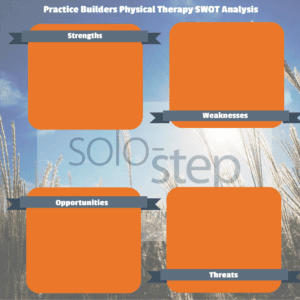[Practice Builders #3] Ever Wonder How the Business Pros Make Intelligent Decisions?
Our next step in showing you how to build the physical therapy practice of your dreams is to get just a little more formalized about some aspects of your dream practice.
It’s very easy to surround yourself with cheerleaders, yes men and woman who will tell you anything you want to hear. They’ll tell you how great your ideas are, even if they are only “so-so” ideas. We want to actually help you move your ideas down the road and achieve your goals.
There is an art to building a physical therapy business but with with love and lots of hard work you can get there! The most natural next to creating your physical therapy business is to conduct a SWOT analysis.
SWOT Analysis: The SWOT analysis is a common business tool for strategic planning. It can be used at any point in the creation or continuity of your business. This analysis will help get from the idea stage to the implementation stage with the correct business intelligence to move forward.
In the correct space in the graphic below enter in your responses to the following questions. Keep in mind these are merely starting points to get you thinking. You can go through the exercise multiple times and drill deeper and deeper into your analysis each time.
1. Strengths: What advantages does your organization have? What do you do better than anyone else? What unique or lowest-cost resources can you draw upon that others can’t? What do people in your market see as your strengths? What factors mean that you “get the sale”? What is your organization’s Unique Selling Proposition (USP)?
2. Weaknesses: What could you improve? What should you avoid? What are people in your market likely to see as weaknesses? What factors lose you sales?
3. Opportunities: What good opportunities can you spot? What interesting trends are you aware of? Useful opportunities can come from such things as: Changes in technology and markets on both a broad and narrow scale. Changes in government policy related to yourfield. Changes in social patterns, population profiles, lifestyle changes, and so on. Local events
4. Threats: What obstacles do you face? What are your competitors doing? Are quality standards or specifications for your job, products or services changing? Is changing technology threatening your position? Do you have bad debt or cash-flow problems? Could any of your weaknesses seriously threaten your business?
CLICK ON THE IMAGE FOR FULL SIZE:
In conclusion, the SWOT Analysis is a simple but useful framework for analyzing your organization’s strengths and weaknesses, and the opportunities and threats that you face. It helps you focus on your strengths, minimize threats, and take the greatest possible advantage of opportunities available to you. SWOT Analysis can be used to “kick off” strategy formulation, or in a more sophisticated way as a serious strategy tool. You can also use it to get an understanding of your competitors, which can give you the insights you need to craft a coherent and successful competitive position. When carrying out your SWOT Analysis, be realistic and rigorous. Apply it at the right level, and supplement it with other option-generation tools where appropriate. (1)
(1) https://www.washington.edu/research/rapid/resources/toolsTemplates/SWOT_analysis.pdf
